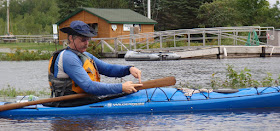 Basics: Launch Just before the Bridge on Route 116. (Exit 199 off I-95, south less than a mile on Route 16, left onto Rt 166, Southgate Rd) less than a mile to the launch. ) This launch is just a dirt ramp before the bridge abutment, there are no facilities, and limited parking. It sees regular use, both for those accessing Birch Stream and those accessing the Penobscot River. (This ramp is the same as the stop halfway around Orson Island) 6 miles, two hours.
Basics: Launch Just before the Bridge on Route 116. (Exit 199 off I-95, south less than a mile on Route 16, left onto Rt 166, Southgate Rd) less than a mile to the launch. ) This launch is just a dirt ramp before the bridge abutment, there are no facilities, and limited parking. It sees regular use, both for those accessing Birch Stream and those accessing the Penobscot River. (This ramp is the same as the stop halfway around Orson Island) 6 miles, two hours. It’s definitely fall, and our records show that sometime in the next two weeks we’ll probably have our last ocean paddle. Not this week though, the weather has been too erratic: thunderstorms, rain or high wind have graced every day . Color is coming in gradually, some maples are at their peak, others just beginning to turn. Since red(swamp) maples are often the first to turn, we thought a paddle on a stream might present some beautiful colors. Plus a twisty stream is unlikely to be affected by all but the most powerful winds.
It’s definitely fall, and our records show that sometime in the next two weeks we’ll probably have our last ocean paddle. Not this week though, the weather has been too erratic: thunderstorms, rain or high wind have graced every day . Color is coming in gradually, some maples are at their peak, others just beginning to turn. Since red(swamp) maples are often the first to turn, we thought a paddle on a stream might present some beautiful colors. Plus a twisty stream is unlikely to be affected by all but the most powerful winds.We’ve never paddled on Birch Stream before, and were a little nervous about how narrow it appears on the Delorme maps. When we paddled around Orson Island last weekend, the Penobscot River was frequently shallow enough that bottom showed. Would a tributary be better, or would we dead end at a beaver dam?
As it turns out, it was deeper than my paddle. The color was varied, some sections unchanged, others at peak, and even some bare branches.
 And the bright green of the rushes at the water’s edge made a great contrast.
And the bright green of the rushes at the water’s edge made a great contrast.
The stream is home to many beavers, I counted six lodges on our way north.
 There are side pockets along the stream but none of them went very deep, at least in the section we paddled. Note the many pale birch trunks.
There are side pockets along the stream but none of them went very deep, at least in the section we paddled. Note the many pale birch trunks. I like this red maple because though it has barely changed, some leaves are completely red and others totally yellow.
I like this red maple because though it has barely changed, some leaves are completely red and others totally yellow.  We didn’t see much wildlife, a heron, some cormorants and ducks, a few kingfishers. And this poor frog, hoping for enough sunlight to escape the many frog loving predators.
We didn’t see much wildlife, a heron, some cormorants and ducks, a few kingfishers. And this poor frog, hoping for enough sunlight to escape the many frog loving predators. We turned around shortly after passing under I-95, one bridge of the highway is new, the other much older.
We turned around shortly after passing under I-95, one bridge of the highway is new, the other much older. We did see a little sunlight on the way back – Yay!
We did see a little sunlight on the way back – Yay!





















































